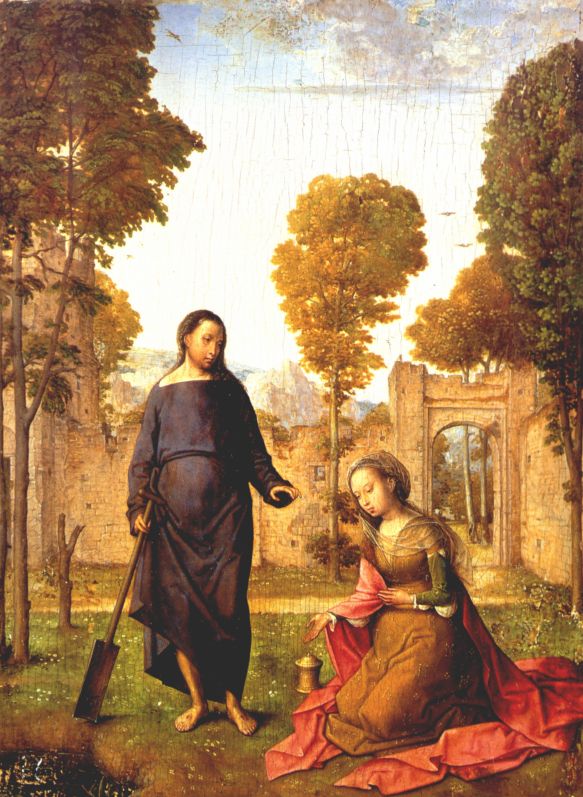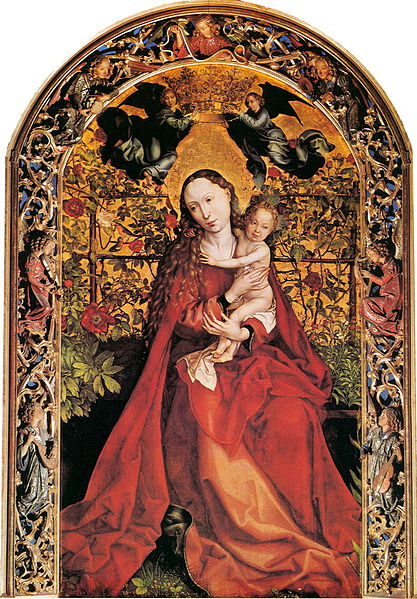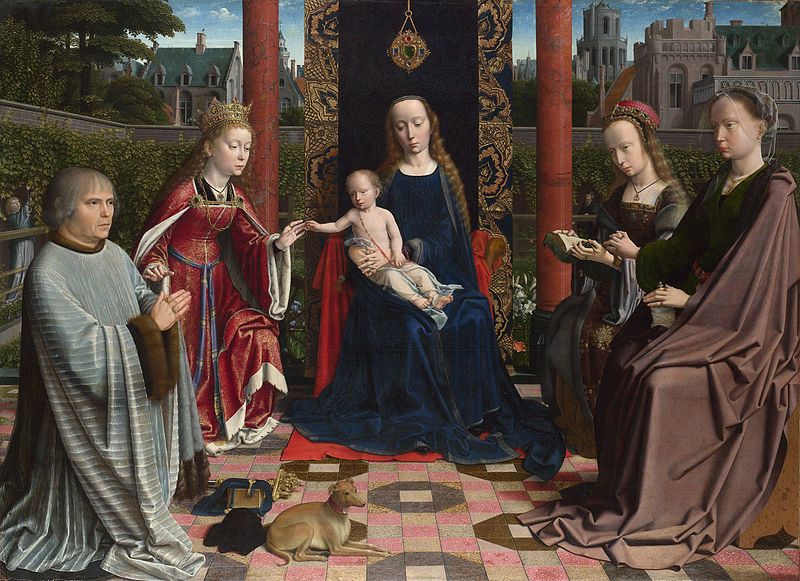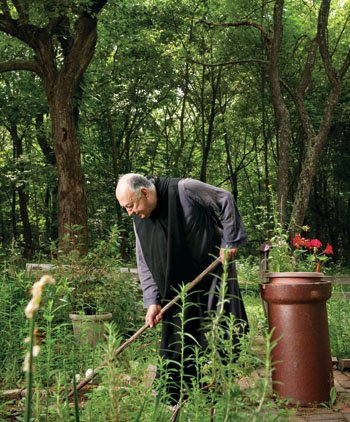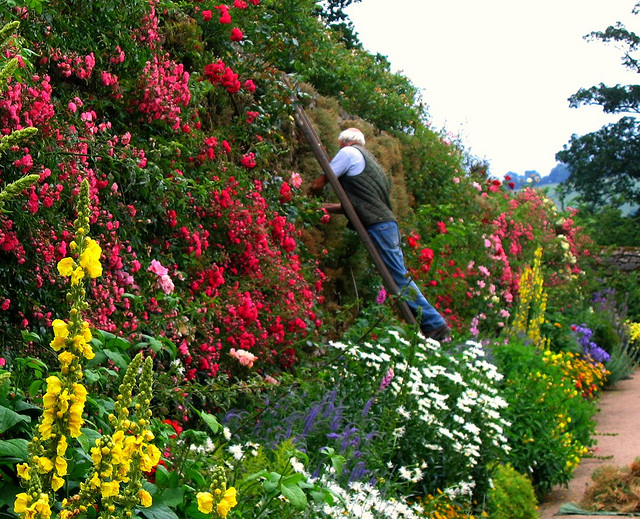 Is gardening for beauty and delight a male or a female occupation? Talking to many here in the US, the impression I get is that people see growing food for produce, or rearing animals for food as a masculine thing; but growing a garden for its beauty? Definitely not. They will rear chickens in their back yard, but growing flowers? No, that is for girls.
In response to this I would say that the call of every man to cultivate the land, should have 'three acres and cow' is at once too narrow and too broad: narrow in that seems to imply that only a utilitarian view of cultivation; and broad in not every man is meant to be cultivating even three acres of land, but he should at least have a plant-pot and a geranium on the windowsill of his 3rd floor city-centre apartment! Adam was gardener; Christ, the new Adam, was mistaken for a gardener and my great grandfather was head gardener of the Duke of Northumberland (so the family lore goes). Also my grandfather was a keen amateur gardener and my father still is a devoted gardener, who also had a garden-nursery a garden design consultancy business. All were men! Perhaps this is a little family line of the 'Downton Abbey' old world pro aristocracy view of life in which every man has his proper place passing down through the family line, holding out against modernist utilitarian view of the land.
Is gardening for beauty and delight a male or a female occupation? Talking to many here in the US, the impression I get is that people see growing food for produce, or rearing animals for food as a masculine thing; but growing a garden for its beauty? Definitely not. They will rear chickens in their back yard, but growing flowers? No, that is for girls.
In response to this I would say that the call of every man to cultivate the land, should have 'three acres and cow' is at once too narrow and too broad: narrow in that seems to imply that only a utilitarian view of cultivation; and broad in not every man is meant to be cultivating even three acres of land, but he should at least have a plant-pot and a geranium on the windowsill of his 3rd floor city-centre apartment! Adam was gardener; Christ, the new Adam, was mistaken for a gardener and my great grandfather was head gardener of the Duke of Northumberland (so the family lore goes). Also my grandfather was a keen amateur gardener and my father still is a devoted gardener, who also had a garden-nursery a garden design consultancy business. All were men! Perhaps this is a little family line of the 'Downton Abbey' old world pro aristocracy view of life in which every man has his proper place passing down through the family line, holding out against modernist utilitarian view of the land.
The garden is a place for relaxation and contemplation for city dwellers. The city being the place of culture and the natural place for man to live (according to psalm 106 and Aristotle alike). The city garden then is a sanctuary and is described in scripture as a place in which everything is grown for its beauty and to delight the senses - taste, smell, vision - rather than simply sustenance.
Also, I note, Christ went to the Garden of Gethsemene to pray. He went to the wilderness to meet the devil; but he went to the garden to find the Father in his time of agony. The garden is a sanctuary of the natural world raised up by man to something greater, so that contemplation of its enhanced beauty raises our spirits to God and as such prompts our praise of God the Father in a way that even the beauty of the wilderness is unable to do. When Mary Magadalene saw Christ in the garden, as mentioned above, she mistook him for the gardener, which seems to me to be symbolic of who this was, she was seeing more than we might give her credit for.
Reading the book of Revelation, that too seems to suggest that man is meant to be a city dweller, for our final home will be the liturgical city of the New Jerusalem. But this is a garden city in which the Tree of Life flourishes and Eden has been restored by Christ the Head Gardener.
I wonder if the root cause of the idea that flowers are cissy is the same as that which has created the tendency towards the feminisation of the prayer in the Church (leading in turn to a reduction in the number of priests)? It seems to me that it is, although I can't say exactly how - perhaps this removal of anything contemplative from masculine list of activities is a common element.
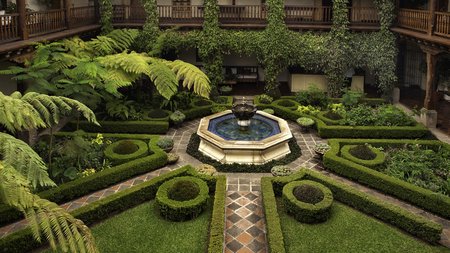 Perhaps then, accordingly, just as we should be encouraging fathers to lead prayer in the home we should also be encouraging boys to start growing things so that contribute to the beauty of our homes and cities and make them sanctuaries of peace as a gift for the family (even if it begins with just in a plant pot inside the house).
Perhaps then, accordingly, just as we should be encouraging fathers to lead prayer in the home we should also be encouraging boys to start growing things so that contribute to the beauty of our homes and cities and make them sanctuaries of peace as a gift for the family (even if it begins with just in a plant pot inside the house).
I am not suggesting that macho men should discover their inner femininity, rather, that we need to learn to see that cultivation for beauty is as thoroughly masculine as it is feminine. For as Leo XIII say in his encyclical Rerum Novarum, men should be encouraged to cultivate the land and in so doing will, 'learn to love the very soil that yields in response to the labor of their hands, not only food to eat, but an abundance of good things for themselves and those that are dear to them [my emphasis].'
Consistent of this idea of the gardener growing good things for those that are dear to him, to use Leo's phrase, we see in the Song of Songs that while the garden is identified with the lady, commonly seen as Mary, a 'garden enclosed'; it is the man who is the gardener who woos her by growing and gathering lilies for her. What strikes me when I look at the traditional pictures of the garden enclosed shown below, is not how our attitude to Mary has changed, but how are attitude to nature and gardens, even as Christians, has changed. I wrote an article that touches on this called Come Out of the Wilderness and Into the Garden . It is this differing attitude to gardens and man's relationship to them that makes this identification of Mary as the garden enclosed so unusual to us today.
As an aside: reading again through Anton Chekhov's the Head Gardener's Tale (and I can't remember why I had cause to read through it the first time!) it is interesting to note that in this short story written in 1894, the gardener is proud of his position, for we are told he calls himself 'Head Gardener' even though he is the only gardener and has no subordinates. The scene is a sale of flowers in 'Count N's greenhouses'. He tells a tale to the narrator in which a judge acquits a vagrant for the brutal murder of an just and beloved village doctor. The tale itself seems to my unlearned appreciation to be asking questions about how justice and mercy are balanced (and I'm not sure I'm with Checkhov in what appear to be his conclusions...perhaps some literature experts can interpret for us, the story is here - it really is very short!) What I find particularly curious, is that Checkhov made the narrator of the tale, who a mysterious sage, an aristocrat's gardener. Is there any significance I wonder? Comments please!
Pictures below is Noli me tangere by John of Flanders, 14th century - Christ with holy spade! And below that: Martin Schongauer, Madonna in Rose Garden, 15th century; and below: Gerard David, early 15th century Flemish.
and finally, below, the York Psalter, 12th century

